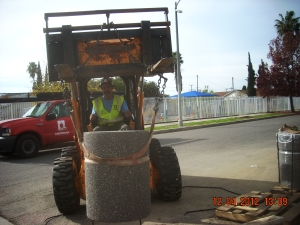
It’s now been over a year since the completion of the Elmer Paseo, a new, walkable alleyway that is designed to help water to soak into the aquifer. Even during the drought, the Paseo has weathered several storms, allowing us to test the system. The good news is that it is performing very well!
Our researchers documented the Paseo during construction and over the past year. Lots of people, including students from Sun Valley Middle School, have been enjoying their new Paseo.
The plant life, which is native to the Sun Valley Watershed, plays an important role in indicating the amount of water (or lack thereof) moving through the Paseo. The return of rain was a welcome restorative.
The monitoring equipment in the Paseo and on Elmer Avenue are allowing us to gather data on water quantity and quality to better understand how the project is performing. We just took our first samples from the lysimeter beneath Elmer Avenue, thanks to the recent storm. This lysimeter was installed with help from the Water Replenishment District of Southern California. We’re testing the quality of the water that we’re putting in the San Fernando groundwater basin. The data will help us understand the success of the treatment train.
All combined, including additional improvements, the projects are designed to treat stormwater from 60 acres and capture as much as 40 acre-feet of water in an average rainfall year.
Many people have toured the award-winning green infrastructure project, Elmer Avenue Neighborhood Retrofit, and Elmer Paseo. If you would like a tour of these projects, please add your contact information here.
W I N T E R

Establishment: Setting roots with rain from storms in January in February.
Aesthetic: The new plants are still small and spaced.
S P R I N G

Establishment: With the help of the rain, the plants are growing.
Aesthetic: The first blossoms are emerging, and the plants gain some height.
S U M M E R

Establishment: Major growth period, with the help of irrigation
Aesthetic: Filled in, but with some bare spots from plants lost to sun exposure
F A L L

Establishment: Dormancy period
Aesthetic: Colors shift from vibrant greens to golds and reds
W I N T E R ( # 2 )

Establishment: After a long stretch without rain, the plants are refreshed by rain.
Aesthetic: Hints of spring, and the first blossoms of color.

The Water Augmentation Study; Elmer Avenue Neighborhood Retrofit Project and Elmer Avenue Paseo have been made possible thanks to funding from:
CALFED Bay-Delta Watershed Program; California Department of Water Resources; City of Los Angeles, Proposition O; City of Long Beach, Stormwater Management Division; City of Los Angeles Bureau of Sanitation, Watershed Protection Division; Los Angeles Department of Water and Power; Los Angeles County Department of Public Works; Los Angeles Regional Water Quality Control Board; Metropolitan Water District of Southern California; Santa Monica Environmental Programs Division; Santa Monica Mountains Conservancy; State of California Strategic Growth Council; State Water Resources Control Board; U.S. Department of the Interior, Bureau of Reclamation; Water Replenishment District of Southern California
Additional support provided by:
The Residents of Elmer Avenue; Congresswoman Linda Sanchez; Graffitti Busters; Pomona College; Los Angeles Bureau of Street Lighting; Los Angeles Bureau of Street Services; Rainbird Corporation; Southern California Gas Company; Sun Valley Neighborhood Council; The Toro Company; TreePeople; University of California Riverside; Upper Los Angeles River Area Watermaster; Vulcan Materials Company
 Our travels to Greece this summer for a conference on the Mediterranean City 2014: Adaptation Strategies to Global Environmental Change allowed us to explore the similarities and differences between “The Mediterranean” and Los Angeles, which shares the same climate. Follow the link below for an account of the conference by Laurel Hunt, who interned at Council for Watershed Health last year. Of course, cats are everywhere. This kitty was hanging out at our lunch place.
Our travels to Greece this summer for a conference on the Mediterranean City 2014: Adaptation Strategies to Global Environmental Change allowed us to explore the similarities and differences between “The Mediterranean” and Los Angeles, which shares the same climate. Follow the link below for an account of the conference by Laurel Hunt, who interned at Council for Watershed Health last year. Of course, cats are everywhere. This kitty was hanging out at our lunch place.

































